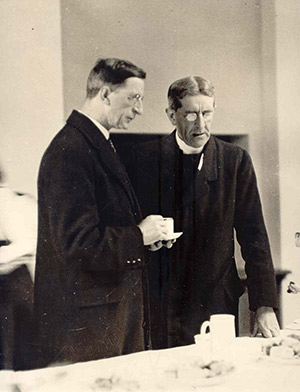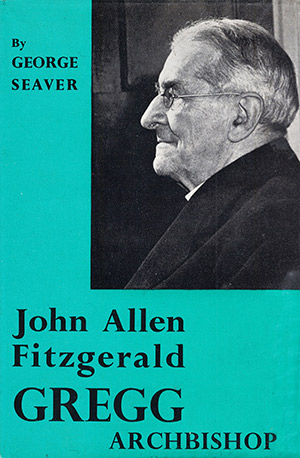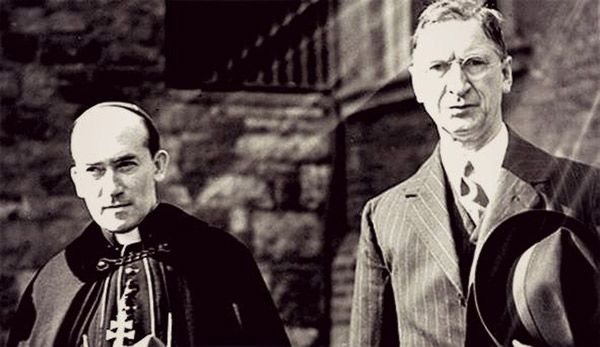Article 44 reconsidered
Published in Features, Issue 1 (January/February 2019), Volume 27The ‘special position’ of the Roman Catholic Church, the Anglicans and the historians.
By Niall Meehan

Historians in southern Ireland who examine the interaction of religion with social and political policy tend to fixate on the Roman Catholic Church. Southern Protestants and their socio-economic, political and religious interactions within wider society are often ignored. Though over 90% of southerners were, for a long period, Roman Catholic, were other denominations as irrelevant as this absence of consideration appears to suggest?
Churches and state
I look here at a much-relied-on, pioneering and, generally, highly astute account, J.H. Whyte’s Church and state in modern Ireland, 1923–1970 (1971). Whyte interviewed ten Roman Catholic clergymen, including five bishops, in a book devoted to that church’s role in independent Ireland. These geographical and denominational limitations produced avoidable interpretive weaknesses.
Article 44.1.2 of the 1937 Constitution recognised the ‘special position of the Holy Catholic and Apostolic Roman Church as the guardian of the faith professed by the great majority of citizens’. It recognised also, in 44.1.3, the Church of Ireland, Presbyterian and Methodist churches, the Religious Society of Friends, Jewish congregations and ‘other Christian Churches’ existing at that time.
The affirmation of a ‘special position’ represented, said Whyte, ‘[o]ne more instance of the movement … to enshrine Catholic principles in the law of the land’. It marked ‘the culmination of [a] process’ in which ‘the Irish state appeared wholly committed to the maintenance of Catholic values’. Whyte ignored published evidence from the Church of Ireland that should have qualified his observations. Owing to the unavailability of archival records, the extent of consultation with the Roman Catholic Church in framing Article 44 was unclear in 1971. Evidence of consultation with the Church of Ireland was, however, available.

George Seaver’s biography of Dr John Gregg, Church of Ireland archbishop of Dublin (1919–39), published in 1963, reported that Éamon de Valera, president of the Free State Executive Council, sought Gregg’s advice in April 1937. Article 44, which he thought would be the easiest to write, occasioned exceptional difficulties. How, for instance, should something as apparently simple as listing various denominations in Article 44 be accomplished? De Valera was aware that his church’s insistence on being termed ‘Catholic’ offended Anglicans, who also considered themselves catholic (with a small ‘c’). Some even disliked the description ‘Protestant’. If Catholics disdained a ‘Roman’ prefix, Protestants largely preferred it, as indicating a denomination within an otherwise universal Christian church, which Roman Catholics were instructed that they alone constituted. A book in Gregg’s study, on decrees of the Council of Trent, contained the official name of the Roman Catholic Church. This suggested a solution that de Valera adopted. The Constitution should identify each church as it ‘designate[d] itself’.
A later Dublin Church of Ireland archbishop, Otto Simms, mentioned the meeting and its outcome in a 1969 Irish Times article by John Horgan. Whyte cited the article but not Simms. He noted instead that Cardinal McRory and Pope Pius XI were not ‘altogether satisfied’ with Article 44. Following up the Gregg reference would have explained why.
A sensation of failure to deal with palpable evidence is reinforced by Whyte’s brief citation of the Seaver biography. The reference was in a ‘Conclusion’ chapter footnote, separated by 300 pages from the Article 44 commentary. Seaver’s confirmation that Gregg and de Valera discussed Article 44 gave Whyte ‘some indications’ that Gregg was consulted, but the fact served merely to establish for Whyte that Roman Catholic authorities must also have been consulted.
De Valera also spoke on a number of occasions to Revd James Alex Irwin, a Presbyterian minister, who was instrumental in obtaining his church’s support for Article 44. Irwin was a long-standing political and personal friend, who spoke with de Valera in the US in 1919–20. There, Irwin confounded Ulster unionist and British attempts to depict Irish republicanism as a Roman Catholic phenomenon and the Anglo-Irish conflict as essentially religious. Unionist depictions of Irwin as ‘a Jesuit in disguise’ proved unsuccessful, not least since Mrs Irwin accompanied her husband. Irwin was elected to the Fianna Fáil party national executive from 1945 until his death in 1954. The interchange was probably as agreeable as that with Gregg.
Protestant church leaders expressed themselves content with the ‘special position’ provision. It appeared a factual statement, not unusual by comparative international standards. Protestant churches were named in the next subsection, followed by guarantees of religious freedom. In the Irish Jurist in 2005 Gerard Hogan critiqued Roy Foster and David Fitzpatrick’s view of the Constitution as essentially a Roman Catholic document. Hogan concluded that it was primarily liberal democratic, even ‘Protestant’, with Roman Catholic influences. Had de Valera followed the UK’s example, he observed, the president, chief justice and minister for justice would have been required to be Roman Catholic. RC bishops would have sat in the Senate as of right, and Roman Catholicism would have been established as a state religion.
Roman Catholic reaction
If Anglicans and Presbyterians were not unduly concerned by Article 44, the Irish Roman Catholic Church was. It had sought confirmation as ‘the one true Church’. The other—in its view heretical—institutions listed in the state’s primary legal document were not regarded as churches, properly speaking. The majority church, designated ‘Roman’, was not even identified as specifically ‘Irish’, though Protestant churches were. To add insult to injury, de Valera trumped local opposition by obtaining the pope’s commitment to neutrality on Article 44 and also confirmation of the church’s official name. The outcome of the Tilson case (see sidebar, p. 46) confirmed initial suspicions about the ineffectiveness of the ‘special position’ clause.
These combined efforts snookered local Roman Catholic expectations. The finalised text caused a temporary break in relations between de Valera and John Charles McQuaid, a clergyman mistakenly assumed to have been the Constitution’s éminence grise, with whom de Valera was long associated.
Whyte’s second edition (1980) left his main text unaltered, although he did add some ‘Reconsiderations: 1923–70’, which addressed Seaver’s account (previously ignored) of the Gregg–de Valera meeting. Whyte first cited identical information in the Irish- and English-language editions of Pakenham and O’Neill’s biography of Éamon de Valera, which had been published on 22 October 1970, six months prior to the 23 April 1971 appearance of Whyte’s first edition. Confusingly, however, in 1980 Whyte stated that the 1970 de Valera biography had appeared ‘just after [his own] first edition… was completed’. It is possible that Whyte’s typescript was finalised before the de Valera biography appeared and that he was not inclined, or was unable, to change it. That still left hanging the fact that Seaver’s text had confirmed the events in question way back in 1963.
In addition, Whyte’s first (as well as his second) edition noted that parts of the Constitution ‘were obviously marked by Catholic thought’. He added that ‘the forthcoming [Irish-language] second volume of [de Valera’s] authorised biography’ would elucidate the matter. A three-part Irish Times series summarising Whyte’s research appeared on 14–16 April 1971 but did not clarify the record on Article 44. The author’s argument may have overcome evidence that queried it.
In 2015 Ronan Fanning discussed Article 44 in Éamon de Valera: a will to power. He also failed to acknowledge the contribution of the Presbyterian and Anglican clergymen. He merely stated, referencing the Pakenham/O’Neill biography, that unnamed ‘heads of’ unidentified ‘other churches’ were consulted. Fanning’s vagueness is surprising, given that in the Irish Times in 1987, after the release of a first tranche of de Valera’s papers, he had raised the Article 44 quarrel with McQuaid. Gregg and Irwin were mentioned, though not their role. A subsequent letter from J.L.B. Deane of the Church of Ireland, citing Seaver, noted that Gregg’s intervention had probably upset McQuaid. A letter on the same theme from de Valera papers consultant archivist Brendán Mac Giolla Choille was then published.
Protestant intervention was reduced again to an unwarranted passivity in Fanning’s text.
‘Special position’ and naming denominations removed
Sections of the Constitution were socially regressive and sectarian even by 1937 standards, for example the ban on divorce and reference to women’s (as distinct from men’s) ‘duties in the home’. It is arguable, too, that the ‘special position’ clause gave an appearance of conferring privilege. Article 44.1.1 opened with the assertion that ‘homage of public worship is due to Almighty God’. That was sectarian, though not in a specifically Roman Catholic sense. It disadvantaged citizens without religious inclinations. In notes that de Valera prepared for use in April 1937 discussions with the papal nuncio it was asserted that ‘The combined influence of the churches will be united against atheism’.
Whyte’s approach was part of an emerging Catholic-centric ‘groupthink’ among historians. Not for the first time in analysis of Irish society, Protestants—their churches, businesses and organisations—in southern Ireland were ignored. An impression is left that addressing Irish Protestants’ actual roles and influence would overly complicate a message in which Irish Roman Catholicism, nationalism and republicanism form part of a continuum. It is an approach that, in particular, affects accounts of the 1919–21 War of Independence. It has had the advantage of harnessing secular and ‘liberal’ views to ‘revisionist’ sentiments that emerged during the post-1968 ‘long war’ in Northern Ireland.

As Gerard Hogan pointed out, depictions of the 1937 Constitution as predominantly ‘Catholic’ formed part of an attempt during the 1970s to ‘eradicate those features of Irish society which were seen as confessional or offensive to the minority religious and political traditions’. Ronan Fanning noted that on 7 December 1972, ‘as a gesture towards Protestant sensibilities under the impact of the Northern Ireland crisis’, the sections of Article 44 naming religious denominations were deleted, with 85% voting in support. It removed a stick with which northern unionists, adopting Whyte’s narrative, beat Irish nationalism. The result had no discernible effect, however, on the unionist attitudes that had provided the incentive for removing it.
A provision said to be the linchpin of the Constitution’s ‘Catholic’ character was in fact influenced by Protestant churchmen, in the teeth of Roman Catholic opposition. In fact, Roman Catholic sensibilities were assuaged in 1972 when a provision placing Roman Catholicism on a constitutional par with other Christians was removed.
Paying adequate attention to Protestant contributions offers a more nuanced picture of southern Irish society. The state controlled its citizens through clerical control of social service, education and health delivery. While the Roman Catholic Church was dominant, all of the churches cooperated in segregating their flocks at the behest of a state that preserved the status quo and its attendant inequalities. Secular conservatism flourished on the basis of Roman Catholic access to and dominance over poorer communities. That is why, though the largely Roman Catholic-inspired ban on abortion was defeated in 2018, the poor are still very much with us.
Niall Meehan is head of the Journalism and Media Faculty in Griffith College Dublin.
Read More:
Ernest Tilson and the ‘special position’
FURTHER READING
G. Hogan, ‘Foreword’, in D. Keogh & A. McCarthy, The making of the Irish Constitution 1937 (Cork, 2007).
D. Jameson, ‘The religious upbringing of children in “mixed marriages”: the evolution of Irish law’, New Hibernia 18 (2) (2014).
A fully referenced version of this article is available on the History Ireland website.
















